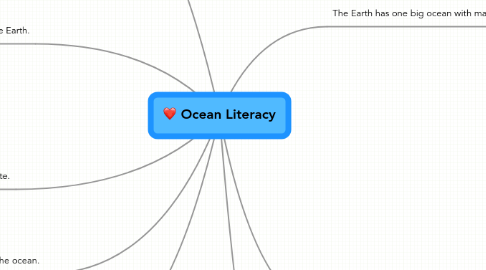
1. The ocean shapes the features of the Earth.
1.1. It is responsible for numerous geochemical cycles.
1.2. It has changed over time thus changing the surface of land.
1.3. through erosion
1.3.1. definition (wearing away of rock and soil from wind, waves, ocean currents)
1.3.2. results in sand
1.4. It affects landforms of the coast.
1.4.1. influenced by tectonic activity
1.4.2. sea level changes
2. The ocean has a major influence on weather and climate.
2.1. ocean dominates Earth's energy, water
2.1.1. affects climate through absorbing heat
2.1.2. affects climate through storing heat
2.1.3. affects climate through moving heat and water
2.2. ocean absorbs much solar heat
2.2.1. evaporation
2.2.2. condensation
2.2.3. precipitation
2.3. carbon cyle
2.3.1. CO2 added to atmosphere
2.4. ocean circulation changes can cause abrupt changes in climate
3. Earth is habitable because of the ocean.
3.1. Most of the O2 originally came from organisms in the ocean.
3.2. First life likely started in the ocean.
4. The ocean is home to a variety of organisms.
4.1. diverse ecosystems
4.1.1. most living space on Earth is in the ocean
4.1.2. more diversity among organisms in ocean than on Earth
4.1.3. many ecosystems in ocean that are independant of sun's energy
4.1.3.1. hydrothermal vents
4.1.3.2. methane cold seeps
4.1.3.3. hot springs
4.2. ocean life varies from very small viruses to very large blue whales
4.2.1. most ocean life exists as microbes- primary producers
4.2.2. adaptations and relationships among these oceanic organisms
4.2.2.1. symbiosis
4.2.2.2. predator/prey
4.3. factors affect diversity of organisms
4.3.1. tides
4.3.2. waves
4.3.3. predation
4.4. National Marine Sanctuaries are used to protect and preserve oceanic organisms.
4.5. ocean habitats are defined by environmental factors thus leaving it "patchy"
4.5.1. light
4.5.2. nutrients
4.5.3. pressure
4.5.4. ph
4.5.5. 02
5. The ocean is largely unexplored.
5.1. less than 5% of the ocean has been explored
5.1.1. New technologies, sensors, tools are expanding our ability to explore the ocean.
5.1.2. Inquiry and study are necessary to have with your curiousity to understand the ocean more fully.
5.2. future sustainability of ocean resources is directly related to our understanding of those resources
5.3. use of mathematical models is an essential part of ocean sciences
5.4. ocean exploration is truly interdisciplinary
5.4.1. meteorologists
5.4.2. biologists
5.4.3. chemists
5.4.4. climatologists
5.4.5. computer programmers
5.4.6. engineers
6. The Earth has one big ocean with many features.
6.1. Planet Earth is dominated by the ocean.
6.1.1. covers 70% of Earth
6.1.1.1. 97% of world's water is in the ocean.
6.1.1.1.1. sea water versus fresh water differences
6.1.1.1.2. salt in the seawater sources
6.1.2. one ocean with many basins
6.1.2.1. Pacific
6.1.2.2. Atlantic
6.1.2.3. Indian
6.1.2.4. Artic
6.1.2.5. ocean is connected to all major lakes and waterways
6.2. ocean's basin varies in size, shape, and features.
6.2.1. islands, trenches, ridges
6.2.2. Earth's highest peaks and deepest valleys are in the ocean.
6.2.3. lithosheric plates affect the ocean basin
6.3. ocean has interconnected circulation system which is affected by numerous factors
6.3.1. winds
6.3.2. tides
6.3.3. Earth's rotation
6.3.4. ocean basin and its connecting land
6.4. Sea level
6.4.1. definition (average height of ocean relative to the land)
6.4.2. affected by tides
6.4.3. changes with plate tectonics
6.4.4. changes as ice caps melt or grow
6.4.5. changes as oceanwater warms and cools
6.5. Ocean is extremely important in the water cycle.
6.5.1. evaporation of ocean
6.5.2. precipitation processes
7. The ocean and humans are inextricably interconnected.
7.1. ocean supplies water, 02, moderates the climate, weather
7.2. foods, medicines, minerals, energy resources all come from the ocean
7.2.1. leads to jobs to support our economy
7.3. much of world's population lives in coastal areas
7.3.1. these lives are affected directly by the ocean
7.3.1.1. tsunamis
7.3.1.2. hurricanes
7.3.1.3. cyclones
7.3.1.4. storm surges
7.4. humans affect the ocean in a variety of positive and negative ways
7.4.1. physical modifications
7.4.2. pollution
7.4.3. National Marine Sanctuaries
7.4.4. we must sustain the ocean
7.5. ocean is a source for inspiration, recreation, discovery
8. ACES Signals of Spring curriculum guide as an aid in classroom studies of ocean literacy.
8.1. classroom activities
8.1.1. photosynthesis
8.1.2. cell structures
8.1.3. biodiversity
8.1.4. data analysis
8.2. research
8.2.1. use of ACES website for satellite imagery
8.2.2. task focuses
8.2.2.1. bathymetry
8.2.2.2. marine species
8.2.2.3. sea surface
8.2.2.4. chlorophyll
8.3. inquiry based instruction
8.3.1. analysis
8.3.1.1. observe animal movements with satellite imagery
8.3.1.2. create justifications with online journaling
8.3.2. investigations
8.3.2.1. work as "investigators" in real world problems
8.3.2.2. interpret results
8.3.2.3. students can achieve to the highest level they are capable of
8.4. teaches students an understanding of the ocean's influence on them and their influence on the ocean.
8.4.1. to be "science literate" one must be "ocean literate"
8.4.2. rids students of common misconceptions about science
8.4.3. group projects allow for social interaction thus socially constructing knowledge
8.4.4. today's National Marine Sanctuaries are critical to the ocean and its organisms
8.4.5. we must protect this vast resource
